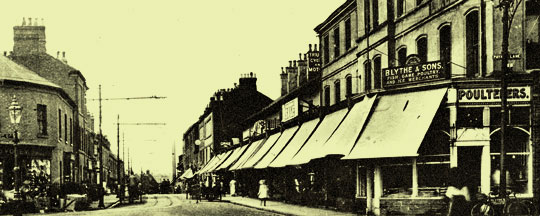Home » Yesterday » Historic Buildings

Far Gosford Street has fourteen listed buildings and number of locally listed and other buildings of historic interest, whose value contributes significantly to the make-up of the conservation area.
Nos 32 and 33
This two-bay medieval or sixteenth century building is much altered, but is a typical example of how an ancient timber-framed building fares over the centuries. Parts of the timber frame get removed over time and brickwork replaces the oak lathe, mud, dung and hair plaster infill panels. The timber frame is still visible above the shop front and indicates that it is a building of the ‘Wealden’ type (see below). The projecting first floor is a ‘jetty.’ If the shop fascias were removed the ends of the chunky ‘jetty’ beams that support the first floor would become visible. One of the bays of the building may have contained the ‘hall,’ the main room in which the medieval occupants lived, with a fire in the centre of the floor and a ventilation space through which the smoke escaped via a vent in the roof.
Nos 38, 39 and 40
This group of buildings is likely to date to the 15th century. No 38 was a double-bay structure forming a single house with 37, which was demolished many years ago. Nos 39-40 formed another double-bay single house, but were built at the same time and were integral with no 41. The latter, although now fronted in brick, was also a double bay house. Medieval houses of this type are called Wealden, one bay of which formed the ‘hall’, opening into the roof, and the other being two storeys with a projecting upper floor or ‘jetty.’
The original timber-framed buildings had brick extensions built onto the rear in the 18th or 19th centuries, much of which had to be demolished due to structural instability.
Vital work on these important buildings to restore them and bring them back into use has been completed.
Nos 122, 123 and 124
This timber framed-building appears to date from the 17th century, but its origins remain a mystery. It does not follow any standard domestic form and may have begun its life as a barn. However, the timber that was used was not ‘green’, that is, from newly-felled timber, but re-used from other buildings, either on the site or from close by.
These buildings were owned by St Michael’s church from the 16th century. This ownership including the 20th century shops, Nos. 126-130. The single brick bay next to the Hand and Heart corresponds to the original opening or gateway to the rear of what would have been a long row of timber-framed buildings.
Nos 67-72 consecutive
These buildings are important and rare survivors of what used to be a common building type in Coventry and district – ribbon weavers’ ‘top shops.’
The three storey houses contained a weaving loom on the top (second floor), hence the large expanse of windows on the front and the rear to provide light. The weaver’s family lived on the floors below.
The ‘top shops’ were built by John Ball in the 1830s, firstly as four (67-70), hence the alley being central to this group, and then as two (71-72). The terrace of ‘top shops’ was built with another of the same length at the rear, backing onto All Saints Lane, now under Sky Blue Way.
Locally Listed buildings
64, 65 & 66: former Pitt’s Head, now Gosford Arms
73-83 (consecutive): Ashville Terrace
93, 94
116: Hertford Arms
154-164: originally Calcott Bros.’ offices,
now Callice Court Coventry University student halls of residence